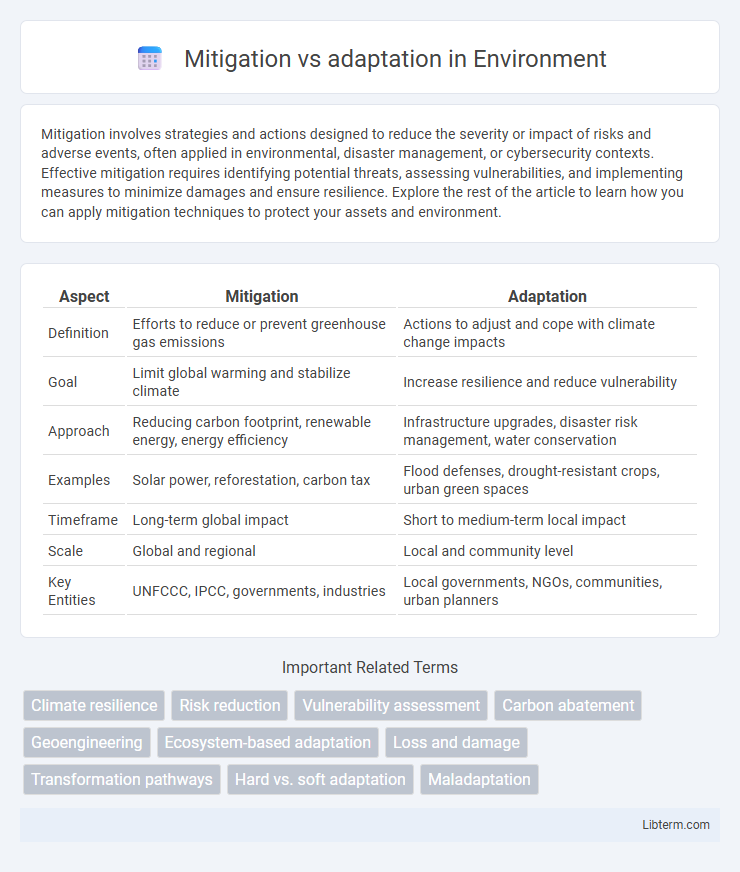Mitigation involves strategies and actions designed to reduce the severity or impact of risks and adverse events, often applied in environmental, disaster management, or cybersecurity contexts. Effective mitigation requires identifying potential threats, assessing vulnerabilities, and implementing measures to minimize damages and ensure resilience. Explore the rest of the article to learn how you can apply mitigation techniques to protect your assets and environment.
Table of Comparison
| Aspect | Mitigation | Adaptation |
|---|---|---|
| Definition | Efforts to reduce or prevent greenhouse gas emissions | Actions to adjust and cope with climate change impacts |
| Goal | Limit global warming and stabilize climate | Increase resilience and reduce vulnerability |
| Approach | Reducing carbon footprint, renewable energy, energy efficiency | Infrastructure upgrades, disaster risk management, water conservation |
| Examples | Solar power, reforestation, carbon tax | Flood defenses, drought-resistant crops, urban green spaces |
| Timeframe | Long-term global impact | Short to medium-term local impact |
| Scale | Global and regional | Local and community level |
| Key Entities | UNFCCC, IPCC, governments, industries | Local governments, NGOs, communities, urban planners |
Understanding Mitigation and Adaptation
Mitigation involves reducing greenhouse gas emissions to limit global warming, primarily through renewable energy adoption, energy efficiency, and carbon capture technologies. Adaptation focuses on adjusting social, economic, and environmental systems to minimize damage from climate change impacts like sea-level rise, extreme weather, and biodiversity loss. Understanding these strategies enables effective policy-making and resilience building in vulnerable regions globally.
Key Differences Between Mitigation and Adaptation
Mitigation involves reducing greenhouse gas emissions to limit the magnitude of climate change, primarily through renewable energy adoption, energy efficiency, and carbon capture. Adaptation focuses on adjusting natural or human systems to minimize the damage caused by climate impacts, such as building flood defenses, modifying agricultural practices, and improving water management. Key differences include mitigation targeting the root causes of climate change, while adaptation addresses its effects and vulnerabilities.
Importance of Climate Change Mitigation
Climate change mitigation is crucial for reducing greenhouse gas emissions to limit global warming and prevent severe environmental impacts, such as extreme weather events and rising sea levels. Implementing renewable energy solutions and enhancing energy efficiency are key strategies that mitigate the root causes of climate change. Effective mitigation efforts can reduce future adaptation costs and safeguard ecosystems, public health, and economies worldwide.
Role of Adaptation in Climate Resilience
Adaptation plays a crucial role in climate resilience by enabling communities and ecosystems to adjust to the adverse effects of climate change, reducing vulnerability and enhancing the capacity to cope with extreme weather events. Effective adaptation strategies include infrastructure improvements, agricultural practice adjustments, and ecosystem restoration, which collectively strengthen long-term sustainability. Unlike mitigation, which aims to reduce greenhouse gas emissions, adaptation addresses the unavoidable impacts already occurring, ensuring social, economic, and environmental systems remain robust against changing climate conditions.
Mitigation Strategies: Examples and Approaches
Mitigation strategies focus on reducing greenhouse gas emissions through approaches such as transitioning to renewable energy sources like solar and wind, implementing energy efficiency measures in buildings and transportation, and promoting carbon capture and storage technologies. Examples include reforestation projects to absorb CO2, adopting electric vehicles to lower fossil fuel dependence, and upgrading industrial processes to minimize emissions. These approaches collectively aim to limit global temperature rise and slow the progression of climate change.
Adaptation Strategies: Examples and Approaches
Adaptation strategies for climate change involve approaches such as enhancing infrastructure resilience, developing drought-resistant crops, and implementing water management systems to reduce vulnerability to environmental impacts. Community-based adaptation emphasizes local knowledge and participation, while ecosystem-based strategies leverage natural systems like wetlands to buffer climate risks. Policy integration ensures that adaptation measures are mainstreamed into urban planning, agriculture, and disaster risk management to build long-term sustainability.
Synergies and Trade-offs Between Mitigation and Adaptation
Synergies between mitigation and adaptation arise when actions reduce greenhouse gas emissions while simultaneously enhancing resilience, such as conserving forests that sequester carbon and protect against climate impacts. Trade-offs occur when resources are limited, forcing stakeholders to prioritize either reducing emissions or adapting infrastructure, potentially leading to suboptimal outcomes in one area. Integrating policies that align mitigation and adaptation goals maximizes co-benefits, improves efficiency, and addresses climate challenges holistically.
Policy Implications for Mitigation and Adaptation
Policy implications for mitigation emphasize the reduction of greenhouse gas emissions through regulations, carbon pricing, and investment in renewable energy technologies to limit global temperature rise. Adaptation policies prioritize enhancing resilience by developing infrastructure, implementing early warning systems, and supporting vulnerable communities to cope with climate impacts. Integrating both mitigation and adaptation strategies into national climate action plans ensures cohesive, long-term sustainability and risk management.
Financing Climate Mitigation vs. Adaptation
Financing climate mitigation involves allocating funds to reduce greenhouse gas emissions through renewable energy projects, energy efficiency improvements, and carbon capture technologies, aiming to limit global temperature rise. Adaptation financing targets enhancing resilience against climate impacts by investing in infrastructure upgrades, disaster risk management, and community-based adaptation strategies to protect vulnerable populations. Balancing investment between mitigation and adaptation is crucial for comprehensive climate policy, with global climate funds like the Green Climate Fund mobilizing resources to support both approaches effectively.
Future Outlook: Integrating Mitigation and Adaptation Efforts
Effective climate strategy increasingly emphasizes the integration of mitigation and adaptation efforts to address future environmental challenges comprehensively. Combining greenhouse gas emission reductions with adaptive measures enhances resilience to climate impacts while simultaneously limiting global warming. Policymakers and stakeholders prioritize synergistic approaches that optimize resource allocation and promote sustainable development pathways for a climate-resilient future.
Mitigation Infographic

 libterm.com
libterm.com